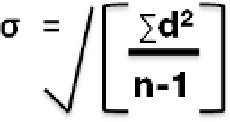Database Reference
In-Depth Information
Ideally, the test team would have been brought in during the architectural phase to give input, because
just like an experienced building inspector, they may be able to point out possible problems that have been
overlooked by the architect. The more experienced the test team is with this type of software, the more useful
their input is during the architectural phase of your BI solution.
In most cases, BI solutions start without much input from testers. But, an effort should be made to formalize
an ongoing test process so that the test team can become more experienced with the solutions you are making.
Doing so will improve each version as it iterates through the BI solution process.
Validation
When developers think of testing, they often think of a person or a piece of software that examines the input
versus the output to ensure validity. For a BI solution, the input is the values inserted into the columns of the data
warehouse that are subsequently processed into the SSAS cubes. The output is the information reported via Excel
and Reporting Services.
The tester's goal is to ensure that an appropriate output is always obtained. This validation is the core of the
testing process.
This is not always as straightforward as it sounds. How are the testers to know what a valid output of a given
input is? Is it implicit through the type of data that is used? Is the output explicitly indicated with some sort of
documentation that can be compared to the results?
Many output results can be determined by examining the values that were input into the columns within a
database, but that is not always the case. Let's look at a couple of examples.
If the input is an author's first and last names and the output is a concatenation, the operation would change
the author's first and last names into one singular name. Incorrect output might display as follows:
•
Leaving no space between the first and last names
•
The last name preceding the first•
•
The first or last name missing
In these examples, your test team should be able to easily establish what the input and output should be and
then verify what is needed by providing the correct information when the reports are generated.
Now let's think of something a little bit more difficult. What about a complex computation that provides
statistical deviations against sales data? In a situation like this, the equation can consist of three or four numerical
values along with a number of operations. The output would be a specific value that is associated with the
algorithm defined by the operation for this calculation. In Figure
18-1
we show an example expression used to
calculate standard deviations.
Figure 18-1.
Notation for a standard deviation expression

